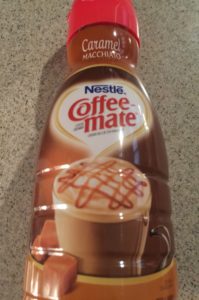Nutrition Facts vs. List of Ingredients
Nutrition Facts vs. List of Ingredients
 Korbie, “I am following my diet, I’m not cheating, I’m doing my cardio, I don’t know why I am not losing weight!!!” This was the start of a lesson learned for one of my personal training clients. After a detailed overview of her food journal, I see that she has been adding sugar free coffee creamer to her coffee. I narrow in on this little additive. For this is the culprit that is preventing her from dropping those few extra pounds. “No Korbie, it definitely can’t be the coffee creamer. For the nutrition facts state that it’s sugar free and has less than one carb per serving”. After seeing this commonality with a few of my clients who are trying to lose weight, I had to lay down the true facts on those not so true nutrition facts!!!
Korbie, “I am following my diet, I’m not cheating, I’m doing my cardio, I don’t know why I am not losing weight!!!” This was the start of a lesson learned for one of my personal training clients. After a detailed overview of her food journal, I see that she has been adding sugar free coffee creamer to her coffee. I narrow in on this little additive. For this is the culprit that is preventing her from dropping those few extra pounds. “No Korbie, it definitely can’t be the coffee creamer. For the nutrition facts state that it’s sugar free and has less than one carb per serving”. After seeing this commonality with a few of my clients who are trying to lose weight, I had to lay down the true facts on those not so true nutrition facts!!!
We’re all familiar with the standard Nutrition Facts label that appears on all packaged foods. The label is mandated by the U.S. Food and Drug Administration (FDA) in accordance with the 1990 Nutrition Labeling and Education Act (NLEA) and requires that values for specific nutrients be reported in a standardized format. This law was intended to provide clearer, more transparent information to consumers, and enable them to compare and contrast the nutritional merits of different products.
Unfortunately, those transparent Nutrition Facts labels are not always transparent much less factual. For starters, the law permits a fairly lax margin of error—up to 20 percent—for the stated value versus actual value of nutrients. Essentially, that means a 100-calorie pack could, theoretically, contain up to 120 calories and still not be violating the law. The sugar free creamer states that there are 0g of sugar and less than 1g of carbohydrates. However, if you read the ingredients, the first listed is dextrose. Dextrose is a form of sugar. Other names for added sugars include corn syrup, high-fructose corn syrup, fruit juice concentrate, maltose, sucrose, honey, and maple syrup. Beware for this doesn’t bode well for diabetics, carb counters or those looking to lose weight. Hungry for more, read my previous blog on hidden sugars.
The same margin of error goes for other nutrients as well. The FDA has never established a systematic, random label-auditing process, and compliance with the law is expected to be self-enforced by food manufacturers. You ask yourself, if these nutrition facts are far from factual, what is one to do in order to reach their fitness goals and get the results they’re looking for? Well I’ll tell you, first and fore most visit a certified specialist in fitness nutrition, like myself, to establish a meal plan that is made for you and your body type. Second, instead of focusing on those nutrition facts, read the ingredients. If there is a laundry list of ingredients you can’t pronounce, chances are you should toss it to the side and go with something more natural. Whole, natural, clean foods, are what you want to consume to feed your body and provide it with the nourishment it deserves. The best guidance I can offer is to minimize the number of foods in your diet that even have a nutrition label; eating more whole, unpackaged, minimally-processed foods is likely to bump up the quality of your diet and minimize the risk of hidden calories. As for those foods that do come in a labeled package, select those with short, recognizable ingredient lists featuring whole grains, nuts, seeds, fruit, and vegetables are most likely to deliver the most nutritional benefits, regardless of what the label states.
For more information on nutrition, weight loss, living a healthier lifestyle, or if you’re frustrated with your current level of fitness and looking to hire a personal trainer, contact us.

